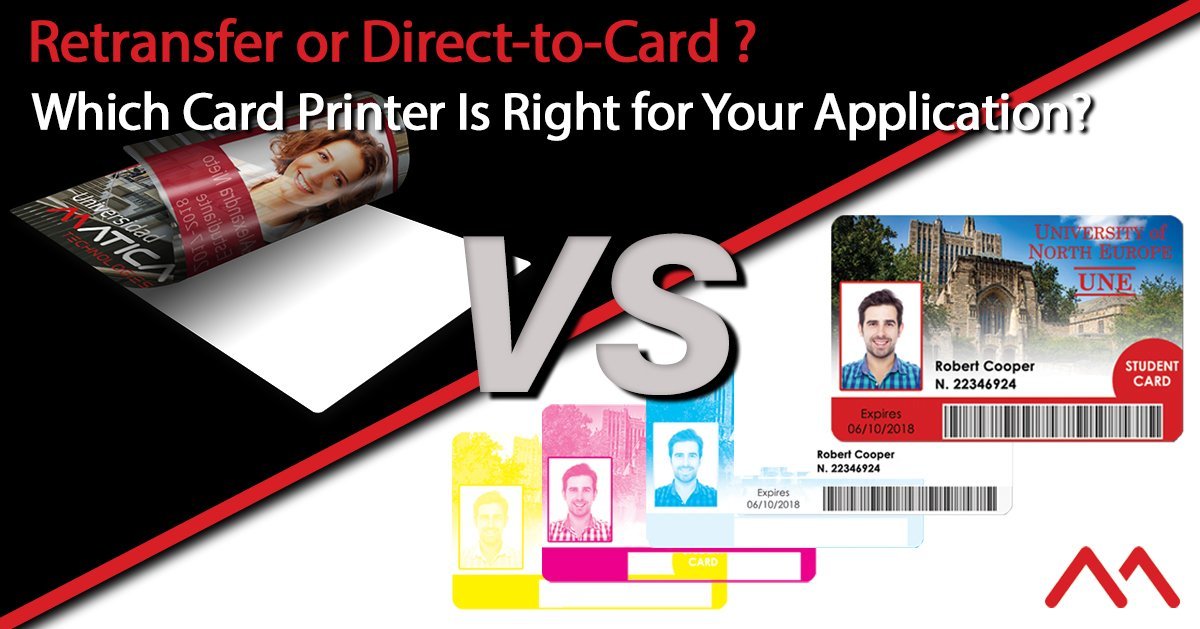One of Matica’s strengths is our product offering. From single-side printers to central issuance systems. From direct-to-card (DTC) to embossing, going through all printing and personalization technologies: dye sublimation, thermal transfer, retransfer printing, laser engraving, ink-jet, embossing, indent, lamination…
When choosing a card printer for your business, you should have mainly four factors in mind:
- Type of card
- Print quality
- Batch printing or on-demand printing
- Cost per card
The most common printing technologies are direct-to-card and retransfer, but what are the differences, and more importantly, how they affect the four points above?
Below we can help you identify them:
1) Type of Card
The type of card may determine the printing method to be used.
Card Material:
- DTC: as its names says (“direct-to-card”), it prints directly on the card surface, using heat to transfer color (dye-sublimation) from a ribbon onto the card. To be printed, the card material must present some porosity to be able to accept the sublimated dyes. In this sense, only PVC or hybrid (composite) with top polished-PVC layer will be printed
- Retransfer printing: in this case, the image is first printed onto a film and then, the film is fused onto the card’s surface. With this printing method, we are more “independent” from the card material because what we really print is the film. Therefore, we can use a wider range of materials. Of course PVC but also PET, ABS, polycarbonate (PC) etc.
Card Surface:
- DTC: if you are printing using DTC, you will need your card to have a polished, perfectly flat surface. The reason is that the printhead is in direct contact with the card surface and this contact must be complete and with a consistent pressure along the card length. Sometimes, the card surface is not perfectly flat due to the presence of electronic components inside (typically the chip in the case of contact or contactless smart cards). This will create an area of bad quality printing and, worst-case scenario, your printhead could be even damaged when using contact-chip cards if the metallic chip contact area scratches your printhead
- Retransfer printing: as said before, with retransfer technology we print a film that is fused onto the card surface once printed. Therefore, the printhead never enters in contact with the card. Uneven card surfaces will not affect the printing quality which will be always perfect and consistent even if the card surface is not flat. That’s the reason why, for contact and contactless smart cards, the recommended printing method is retransfer
2) Print Quality
Resolution:
- DTC: It is only available on 300dpi resolution which is normally enough for the majority of applications. One characteristic is that, when printing the full surface of the card, a very thin white space can be perceived around the edge of the card. This is minimized with the MC310 direct-to-card printer thanks to its TrueEDGE Technology
- Retransfer: Retransfer printing is available in both 300dpi and 600 dpi resolution. This allows to print more detailed images than direct-to-card technology and allows to introduce visual security elements, such as microtext that can only be read under magnifying glasses
Colors:
- DTC: Prints monochrome or full color. It has a wide range of monochrome ribbons available, including metallic silver and gold which allows printing very attractive cards at a very low cost (especially for retail). Also, direct-to-card technology makes available some special printing capabilities such as the use of re-writable cards or scratch-off applications (PIN, PUK occultation, etc.)
- Retransfer: Prints color. Black monochrome is only for personal data. The availability of only monochrome ribbons is very limited. Matica offers a monochrome black ribbon for XID Series of retransfer printers. Images on retransfer appear with more vivid and saturated colors
3) Batch printing or on-demand printing
If you print batch jobs, the speed may be one of the parameters you would like to check when choosing your card printing method.
- DTC: deliver significantly higher card per hour output than retransfer with speeds around 180 cards per hour in color (half panel) and 850 in monochrome
- Retransfer: With Matica’s retransfer, however, you can increase productivity by setting up a “printer farm” having several printers working in parallel as a virtual unique machine thanks to Matica EDIsecure® middleware
4) Cost per card:
The cost per card is always one important point and it is the combination of the cost of the cards itself plus the proportional part of the cost of the ribbon used to print the card.
- DTC: It has a lower TCO (total cost of ownership and it is ideal for small budgets with a lower cost per card compared to retransfer. However, the gap has been reduced over the last years, and some applications that in the past used direct-to-card have migrated to retransfer now, even with a higher cost per card, thanks to the benefits that retransfer offer for those specific applications
Summarizing the advantages:
DTC is a lower cost option that also offers faster print speeds than retransfer and allows some low-cost but attractive print capabilities (monochrome, color, metallic). That is a combination that makes direct-to-card printers the first choice for many high-volume applications and situations where rapid output is a necessity.
Retransfer provides several print-quality advantages, including sharper images, vivid colors, high resolution, and true over-the-edge images on a wider range of card materials and smart cards.
About Matica
Matica is a fast-growing and innovative global company, which develops, manufactures and markets a vast range of products in the secure ID, and payments industries. Matica has a strong international network, operating globally providing local sales and services through its offices in Switzerland (HQ), Italy, Spain, India, Malaysia, China, USA and the UAE. The company supports thousands of customers with its global network of certified resellers, value-added distributors, and system integration partners. For further information, please visit maticagroup.com

